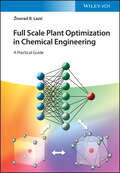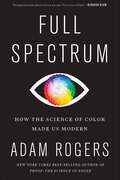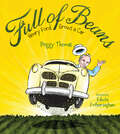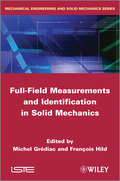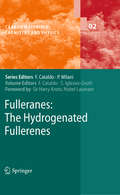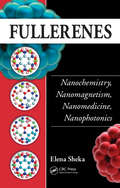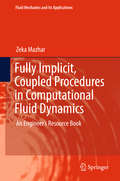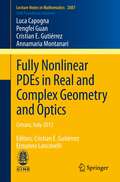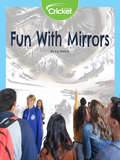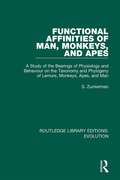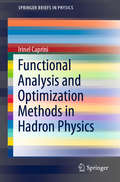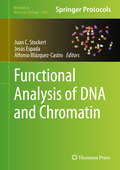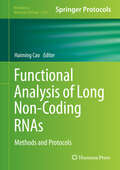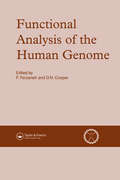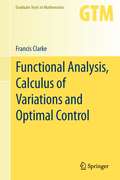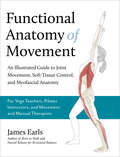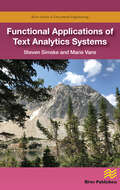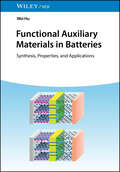- Table View
- List View
Full Scale Plant Optimization in Chemical Engineering: A Practical Guide
by Zivorad R. LazicHelp protect your network with this important reference work on cyber security Chemical engineers are a vital part of the creation of any process development—lab-scale and pilot-scale—for any plant. In fact, they are the lynchpin of later efforts to scale-up and full-scale plant process improvement. As these engineers approach a new project, there are three generally recognized methodologies that are applicable in industry generally: Design of Experiments (DOE), Evolutionary Operations (EVOP), and Data Mining Using Neural Networks (DM). In Full Scale Plant Optimization in Chemical Engineering, experienced chemical engineer Zivorad R. Lazic offers an in-depth analysis and comparison of these three methods in full-scale plant optimization applications. The book is designed to provide the basic principles and necessary information for complete understanding of these three methods (DOE, EVOP, and DM). The application of each model is further described. Full Scale Plant Optimization readers will also find: A thorough discussion of the advantages, disadvantages, and applications of the different simulation methods for process and plant optimization An overview of the tools that responsible operators and engineers utilize in deciding between different simulation models Particular attention is given to the simple but powerful technique Evolutionary Optimization or EVOP, which provides the experimental tools for the ideal full scale plant optimizationFull Scale Plant Optimization is a useful reference for all chemists in industry, chemical engineers, pharmaceutical chemists, and process engineers.
Full Spectrum: How the Science of Color Made Us Modern
by Adam Rogers"Informative and entertaining...Rogers is a seasoned raconteur, unreeling an eons-spanning tale with skill." —Wall Street JournalA lively account of our age-old quest for brighter colors, which changed the way we see the world, from the best-selling author of Proof: The Science of Booze From kelly green to millennial pink, our world is graced with a richness of colors. But our human-made colors haven&’t always matched nature&’s kaleidoscopic array. To reach those brightest heights required millennia of remarkable innovation and a fascinating exchange of ideas between science and craft that&’s allowed for the most luminous manifestations of our built and adorned world. In Full Spectrum, Rogers takes us on that globe-trotting journey, tracing an arc from the earliest humans to our digitized, synthesized present and future. We meet our ancestors mashing charcoal in caves, Silk Road merchants competing for the best ceramics, and textile artists cracking the centuries-old mystery of how colors mix, before shooting to the modern era for high-stakes corporate espionage and the digital revolution that&’s rewriting the rules of color forever. In prose as vibrant as its subject, Rogers opens the door to Oz, sharing the liveliest events of an expansive human quest—to make a brighter, more beautiful world—and along the way, proving why he&’s &“one of the best science writers around.&”* *National Geographic
Full of Beans: Henry Ford Grows a Car
by Peggy ThomasA NSTA/CBC Best STEM BookFamous car-maker and businessman Henry Ford loved beans. And he showed great innovation with his determination to build his most inventive car--one completely made of soybeans.With a mind for ingenuity, Henry Ford looked to improve life for others. After the Great Depression struck, Ford especially wanted to support ailing farmers. For two years, Ford and his team researched ways to use farmers' crops in his Ford Motor Company. They discovered that the soybean was the perfect answer. Soon, Ford's cars contained many soybean plastic parts, and Ford incorporated soybeans into every part of his life. He ate soybeans, he wore clothes made of soybean fabric, and he wanted to drive soybeans, too. Award-winning author Peggy Thomas and illustrator Edwin Fotheringham explore this American icon's little-known quest.
Full-Court Pressure: A Year in Kentucky Basketball
by Dick Weiss Rick PitinoA year in the life of the then-golden boy of college basketball, former Kentucky coach Rick Pitino.
Full-Field Measurements and Identification in Solid Mechanics
by Michel Grédiac François HildThis timely book presents cutting-edge developments by experts in the field on the rapidly developing and scientifically challenging area of full-field measurement techniques used in solid mechanics – including photoelasticity, grid methods, deflectometry, holography, speckle interferometry and digital image correlation. The evaluation of strains and the use of the measurements in subsequent parameter identification techniques to determine material properties are also presented. Since parametric identification techniques require a close coupling of theoretical models and experimental measurements, the book focuses on specific modeling approaches that include finite element model updating, the equilibrium gap method, constitutive equation gap method, virtual field method and reciprocity gap method. In the latter part of the book, the authors discuss two particular applications of selected methods that are of special interest to many investigators: the analysis of localized phenomenon and connections between microstructure and constitutive laws. The final chapter highlights infrared measurements and their use in the mechanics of materials. Written and edited by knowledgeable scientists, experts in their fields, this book will be a valuable resource for all students, faculties and scientists seeking to expand their understanding of an important, growing research area
Fulleranes
by Susana Iglesias-Groth Franco CataldoFulleranes are a special class of carbon molecules derived from fullerenes whose double bonds are partially or at least theoretically fully saturated by hydrogen. The hydrogenation changes the chemical properties of fullerenes which can become susceptible to substitution reactions as opposed to addition reactions to the double bonds (present in common fullerenes). One of the most intriguing aspects of fulleranes is the fact that they have been thought to exist in the interstellar medium or even in certain circumstellar media. "Fulleranes: The Hydrogenated Fullerenes" presents the state of the art research, synthesis and properties of these molecules.This book also includes astrophysicists' and astrochemists' expectations regarding the presence of these molecules in space.
Fullerenes: Nanochemistry, Nanomagnetism, Nanomedicine, Nanophotonics
by Elena ShekaAt the interface between chemistry, biology, and physics, fullerenes were one of the first objects to be dissected, scanned, and studied by the modern multi-specialty biotech community and are currently thriving in both research and practical application. Other members of the sp2 nanocarbon family, such as nanotubes and graphene, are currently bein
Fully Implicit, Coupled Procedures in Computational Fluid Dynamics
by Zeka MazharThis book introduces a new generation of superfast algorithmsfor the treatment of the notoriously difficult velocity-pressure couplingproblem in incompressible fluid flow solutions. It provides all the necessary details for the understanding andimplementation of the procedures. The derivation and construction of thefully-implicit, block-coupled, incomplete decomposition mechanism are given ina systematic, but easy fashion. Worked-out solutions are included, withcomparisons and discussions. A complete program code is included for fasterimplementation of the algorithm. A brief literature review of the developmentof the classical solution procedures is included as well.
Fully Nonlinear PDEs in Real and Complex Geometry and Optics
by Luca Capogna Pengfei Guan Cristian E. Gutiérrez Annamaria MontanariThe purpose of this CIME summer school was to present current areas of research arising both in the theoretical and applied setting that involve fully nonlinear partial different equations. The equations presented in the school stem from the fields of Conformal Mapping Theory, Differential Geometry, Optics, and Geometric Theory of Several Complex Variables. The school consisted of four courses: Extremal problems for quasiconformal mappings in space by Luca Capogna, Fully nonlinear equations in geometry by Pengfei Guan, Monge-Ampere type equations and geometric optics by Cristian E. Gutiérrez, and On the Levi Monge Ampere equation by Annamaria Montanari.
Fun with Hobbies and Science!
by Kelly KongThe third installment of the Reading Street series, Grade 3, delivers structured content designed for children who have a firm foundation in English and Language Arts and are ready to continue on the path to lifelong reading. This curriculum for homeschooling brings together classic reading selections, fun activities and parent/teacher guides to help you develop lessons that boost your student's English and Language Arts learning. As with all levels of Reading Street, Grade 3 was created using educational research to ensure your child is guided through his or her work by age-appropriate and cutting-edge content. Each week, your child will work through a series of reading and writing activities that center around a Big Idea. This structure supports your child's critical thinking skills and ensures he or she builds knowledge suitable for a child in third Grade. By the end of the year, children at this level in their homeschooling program should be able to: Read third-grade level material at a steady pace. Identify errors when reading aloud and know how to correct them. Answer questions using examples from the text. Comprehend and explain main ideas found in the reading. Develop a point of view different than those of characters in stories. Edit writing after completing it. Use transitions in writing, such as "therefore," "for example" and "also. " Reading Street: Grade 3 will give you the tools you need to achieve these learning goals during your homeschool program. Grade 3 comes in a two-volume set that's packed with engaging reading materials and helpful teacher tools. You'll be able to keep tabs on your child's progress through this level by using the assessment materials. If your child needs to revisit a certain lesson, you can ensure he or she does so and fully comprehends the subject. Check out these and other great components of Reading Street: Grade 3 by visiting the Features and Benefits page.
Fun with Mirrors
by Liz HuyckMaking the perfect mirror surface of Chicago's Cloud Gate sculpture took a lot of work.
Fun-Schooling Science Handbook All About Space: Explore The Universe! Research, Create, Play, Experiment and Learn (60 Day Emergency Homeschooling Curriculum Plan)
by Sarah Janisse Brown Melissa Knorr Alexandra Bretush Notika Pachinko60 Day Emergency Homeschooling Curriculum Plan for grades 2 - 6! Explore the Universe! Research, Create, Play, Experiment & Learn! Cover 18 essential educational subjects while learning about space! <p><p> Fun for All Ages! Step-By-Step science activities you can try at home with household products. This is a Fun-Schooling Curriculum Core Journal that covers almost every required subject while the child learns about space!
Function and Evolution of Repeated DNA Sequences
by Guy-Franck RichardThe genome of a living being is composed of DNA sequences with diverse origins. Beyond single-copy genes, whose product has a biological function that can be inferred by experimentation, certain DNA sequences, present in a large number of copies, escape the most refined approaches aimed at elucidating their precise role. The existence of what 20th century geneticists had already perceived (and wrongly described as "junk DNA"!) was confirmed by the sequencing of the first complex genomes, including that of Homo sapiens. A large part of what defines a living thing is not unique, but repeated, sometimes a very large number of times, increasing in complexity with successive duplications and multiplication. Understanding and defining the many functions of this myriad of repeated sequences, as well as their evolution through natural selection, has become one of the major challenges for 21st century genomics.
Function-Oriented Bioengineered Skin Equivalents: Continuous Development Towards Complete Skin Replication (SpringerBriefs in Molecular Science)
by Tina Maver Uroš Maver Karin Stana Kleinschek Tanja ZidaričThe book Function-oriented bioengineered skin equivalents - continuous development towards complete skin replication aims to provide potential readers with a comprehensive summary of the available information on various in vitro skin models, from historical background to different modeling approaches and their applications. Particular emphasis is placed on presenting the current technological components available for the development of engineered skin equivalents by summarizing advances in cell cultivation, materials science, and bioengineering. Using examples of the current-state-of-art, we describe the advantages, limitations, and challenges of developing in vitro skin models for successful use in clinical applications and skin-related research.
Functional Affinities of Man, Monkeys, and Apes: A Study of the Bearings of Physiology and Behaviour on the Taxonomy and Phylogeny of Lemurs, Monkeys, Apes, and Man (Routledge Library Editions: Evolution #15)
by S. ZuckermanOriginally published in 1933 Functional Affinities of Man, Monkeys and Apes gives a taxonomic and phylogenetic survey and the findings of diverse experimental investigations of lemurs, monkeys, and apes. The book discusses the inter-relationships of different Primates and emphasizes seldom-used approaches to the question of primate phylogeny. The book attempts to show how little they have been systematically tried, and argues for a regard to the proper place of functional investigations in the study of the classification and evolution of Primates. This book will be of interest to anthropologists, scientists and historians alike.
Functional Analysis and Optimization Methods in Hadron Physics (SpringerBriefs in Physics)
by Irinel CapriniThis book begins with a brief historical review of the early applications of standard dispersion relations in particle physics. It then presents the modern perspective within the Standard Model, emphasizing the relation of analyticity together with alternative tools applied to strong interactions, such as perturbative and lattice quantum chromodynamics (QCD), as well as chiral perturbation theory. The core of the book argues that, in order to improve the prediction of specific hadronic observables, it is often necessary to resort to methods of complex analysis more sophisticated than the simple Cauchy integral. Accordingly, a separate mathematical chapter is devoted to solving several functional analysis optimization problems. Their applications to physical amplitudes and form factors are discussed in the following chapters, which also demonstrate how to merge the analytic approach with statistical analysis tools. Given its scope, the book offers a valuable guide for researchers working in precision hadronic physics, as well as graduate students who are new to the field.
Functional Analysis of DNA and Chromatin
by Juan C. Stockert Jesús Espada Alfonso Blázquez-CastroIn Functional Analysis of DNA and Chromatin, expert researchers in the field provide an overview of standard and more recent methods for the functional analysis of the genetic material. These include methods on DNA-dye binding modes, chromatin staining, nuclear dispersion assays, DNA labeling in vivo, sister chromatid exchanges, FISH, DNA and chromatin imaging by fluorescence, electron and atomic force microscopy, detection of apoptotic DNA, cytosine methylation and hydroxy-methylation, DNA thermophoresis, improved methods for histone analysis, chromatin immunoprecipitation, and analysis of rDNA genes and chromatin-associated RNA. Written in the highly successful Methods in Molecular Biology series format, chapters include introductions to their respective topics, lists of the necessary materials and reagents, step-by-step, readily reproducible laboratory protocols, and key tips on troubleshooting and avoiding known pitfalls. Authoritative and practical, Functional Analysis of DNA and Chromatin seeks to aid scientists in the further study of cellular and molecular biology of the nucleus.
Functional Analysis of Long Non-Coding RNAs: Methods and Protocols (Methods in Molecular Biology #2254)
by Haiming CaoThis detailed volume presents a comprehensive bioinformatic and experimental toolbox for prioritizing, annotating, and functionally analyzing long non-coding RNAs (lncRNAs). Playing a vital role in diverse biological progresses and human disease, lncRNAs have proven to be a challenging subject of study due to our limited understanding of their sequence-function relationships, lack of complete genetic annotation, and the unavailability of systems required to define their functional importance and molecular mechanisms, all of which this book seeks to address. Written for the highly successful Methods in Molecular Biology series, chapters include introductions to their respective topics, lists of the necessary materials and reagents, step-by-step, readily reproducible laboratory protocols, and tips on troubleshooting and avoiding known pitfalls. Authoritative and practical, Functional Analysis of Long Non-Coding RNAs: Methods and Protocols provides a timely and convenient resource to facilitate the identification and characterization of disease-associated human lncRNAs, which aims to shed light on their role in biology and pathophysiology and ultimately lead toward novel therapeutic approaches targeting lncRNAs for the amelioration of human diseases.
Functional Analysis of the Human Genome
by Farzin Farzaneh and David N. CooperAn excellent review of the relationship between structure and function in the human genome, and a detailed description of some of the important methodologies for unravelling the function of genes and genomic structures.
Functional Analysis, Calculus of Variations and Optimal Control
by Francis ClarkeFunctional analysis owes much of its early impetus to problems that arise in the calculus of variations. In turn, the methods developed there have been applied to optimal control, an area that also requires new tools, such as nonsmooth analysis. This self-contained textbook gives a complete course on all these topics. It is written by a leading specialist who is also a noted expositor. This book provides a thorough introduction to functional analysis and includes many novel elements as well as the standard topics. A short course on nonsmooth analysis and geometry completes the first half of the book whilst the second half concerns the calculus of variations and optimal control. The author provides a comprehensive course on these subjects, from their inception through to the present. A notable feature is the inclusion of recent, unifying developments on regularity, multiplier rules, and the Pontryagin maximum principle, which appear here for the first time in a textbook. Other major themes include existence and Hamilton-Jacobi methods. The many substantial examples, and the more than three hundred exercises, treat such topics as viscosity solutions, nonsmooth Lagrangians, the logarithmic Sobolev inequality, periodic trajectories, and systems theory. They also touch lightly upon several fields of application: mechanics, economics, resources, finance, control engineering. Functional Analysis, Calculus of Variations and Optimal Control is intended to support several different courses at the first-year or second-year graduate level, on functional analysis, on the calculus of variations and optimal control, or on some combination. For this reason, it has been organized with customization in mind. The text also has considerable value as a reference. Besides its advanced results in the calculus of variations and optimal control, its polished presentation of certain other topics (for example convex analysis, measurable selections, metric regularity, and nonsmooth analysis) will be appreciated by researchers in these and related fields.
Functional Anatomy of Movement: An Illustrated Guide to Joint Movement, Soft Tissue Control, and Myofascial Anatomy-- For yoga teachers, pilates instructors & movement & manual therapists
by James EarlsA unique and comprehensive approach to functional anatomy through the lens of myofascial continuities, from the coauthor of Fascial Release for Structural BalanceWhether we describe them as anatomy trains, myofascial chains, meridians, or slings—insights into the interconnected nature of fascial tissue have had a profound impact on our understanding of anatomy.The concept of tensegrity—the idea that changes in tension may affect the whole body rather than just one part—has likewise opened up new appreciations for the complex and interdependent nature of real-world bodily movements. But musculoskeletal anatomy still tends to be taught in a drastically simplified fashion, through the study of fixed anatomical positions that do little to prepare us for the reality of actual movements. In Functional Myofascial Anatomy, James Earls suggests that we need a new set of tools and vocabulary for watching and describing anatomy in motion. Earls argues that it is seeing movement in action—in different bodies and in different environments—that should inform our understanding of anatomy, rather than the other way around.By situating the different theories and metaphors of myofascial continuities against the context of common real-life movements such as sports exercises and yoga asanas, Earls explains how each theoretical system may be useful in different situations and applicable to different issues. Using up-to-date research, Earls digs into important questions for physical and manual therapists: which tissues really are contiguous? Does continuity of tissue actually show or demonstrate transmission of force and communication along those lines? And does fascial tissue have to be continuous for the body to actually transfer force?Accessibly written and fully illustrated, Functional Myofascial Anatomy offers practical applications for physical therapists, chiropractors, and bodyworkers, as well as new tools for teachers of yoga and pilates to develop a deeper understanding of anatomy and movement.
Functional Anatomy of Yoga: A Guide for Practitioners and Teachers
by David KeilA full-color illustrated exploration of the body in motion during yoga practice• Examines anatomical patterns and body mechanics in specific asanas, such as forward bends, twists, external hip rotations, arm balances, and back bends, to inspire confidence in students, deepen practice, and prevent injury • Provides detailed images and photos overlaid with anatomical diagrams, allowing you to see clearly what is happening within each asana discussed • Explores how various yoga postures interrelate from the perspective of functional anatomy In this full-color illustrated guide, David Keil brings the anatomy of the body in yoga asanas to life. Writing in an accessible, conversational tone, he outlines how practitioners and yoga teachers alike can utilize a deeper understanding of their anatomy and its movement and function to deepen their yoga practice, increase confidence, prevent injury, and better understand their students and their challenges. Providing detailed images and photos overlaid with anatomical diagrams, allowing you to see clearly what is happening within each asana discussed, Keil shows how the muscles, joints, tendons, and structure of the body work together to support integrated movement. He discusses the basics of functional anatomy, exploring the workings of the foot and ankle, the knee, the hip joint, the pelvis and SI joint, the spine, the shoulder, and the hand, wrist, and elbow. He examines anatomical patterns and body mechanics in specific asanas, such as forward bends, twists, external hip rotations, arm balances, and back bends, such as, for example, how a wide-legged forward bend shifts the position of the femur and the pelvis, allowing students with tight hamstrings to accomplish a deep forward bend--something they struggle with when the legs are together. Keil also shows how various yoga postures interrelate from the perspective of functional anatomy. Revealing in detail how everything in the body is connected and how your anatomy functions holistically during yoga practice, this book helps you to understand the body better and connect and integrate yoga postures in a completely new way.
Functional Applications of Text Analytics Systems
by Steven Simske Marie VansText analytics consist of the statistics about a text element, which includes the word count, the word histogram, and the word frequency histogram. Most text documents of value are related to other—sometimes many other—documents, and so analytics describing the relative frequency of terms in a document compared to its peers are important for defining key words (tagging, labeling, indexing), search-responsive terms (query terms), and compressed versions of the documents (key words, summary, etc.).This clearly written text explains the functional applications of search, translation, optimization, and learning with regard to text analytics. Generation of analytics is aided by a hybrid, ensemble, or other combinatorial approach in which two or more effective analytic processes are used simultaneously, and their outputs combined to form a better “consensus”. Additional value to the preservation of the information is provided through these methods. Also, since they encompass capabilities of two or more knowledge-generating systems, they can create a “superset” of access points to the data generated. The book also describes the role of functional approaches in the testing and configuration of these systems.
Functional Auxiliary Materials in Batteries: Synthesis, Properties, and Applications
by Wei HuComprehensive reference exploring innovative auxiliary materials as a variety of battery components to enhance battery performance, safety, and longevity Functional Auxiliary Materials in Batteries: Synthesis, Properties, and Applications overviews the latest research on the applications of organic functional materials and low-dimensional structural materials as functional auxiliary materials in batteries. The book introduces the properties and preparation methods of these materials, summarizes the application mechanisms and conclusions, and puts forward novel insights and prospects towards more sustainable and environmentally friendly battery technologies. The first five chapters of this book expand around the application of organic functional materials in batteries, including separators, binders, electrolytes, and functional additives. The last two chapters of this book expand around the application of low-dimensional structural materials in batteries, including conductive agents and functional additives. Functional Auxiliary Materials in Batteries includes information on: Film forming, flame retardant, high voltage, and overcharge protection additives Adjusting factors in biopolymer materials such as molecular structure, composition, and morphology to precisely regulate and optimize battery performance Ionic liquids and single-ion conductors as a more secure and widely usable alternative to traditional organic electrolytes Self-healing materials, covering their positive effects on energy density, cost reduction, safety, and sustainability and their challenges including complexity and material compatibility Carbon-based materials that mitigate polysulfide shuttle effects and extend cycle life Functional Auxiliary Materials in Batteries is an essential reference for new researchers seeking to quickly understand the progress of research in related fields. The book is also valuable for senior researchers seeking inspiration for innovation.
Functional Biochemistry in Health and Disease
by Eric Newsholme Anthony LeechFunctional Biochemistry in Health and Disease provides a clear and straightforward account of the biochemistry that is necessary to understand the physiological functions of tissues or organs essential to the life of human beings. Focusing on the dynamic aspects of biochemistry and its application to the basic functions of the body, the book bridges the gap between biochemistry and medical practice.Carefully structured within five sections, each biochemical, physiological or medical subject that is covered in the book is presented in one complete chapter. Consequently, each subject can be read and studied in isolation although cross-sectional links between the subjects are included where necessary. Background material, both biochemical and medical, that is necessary for an understanding of the subject, is included at the start of each chapter and clear, relevant diagrams enhance students' understanding.Focuses on medically relevant aspects of biochemistry written from a physiological rather than a chemical perspective.Clear presentation that minimises the use of jargon.Each chapter contains boxes on related topics, relevant diagrams and a brief glossary.Coverage includes athletic performance, apoptosis and the immune system.Key historical developments are included to show how modern biochemistry has evolved.By linking biochemistry, medical education and clinical practice this book will prove invaluable to students in medical and health sciences, biomedical science and human biology taking an introductory biochemistry course. In addition it will appeal to biochemistry and biology students interested in clinical applications of biochemistry.
